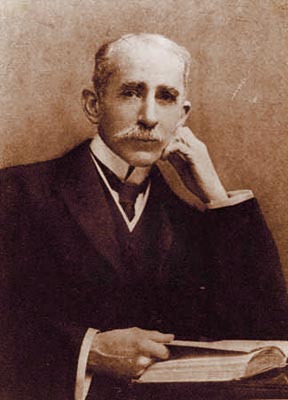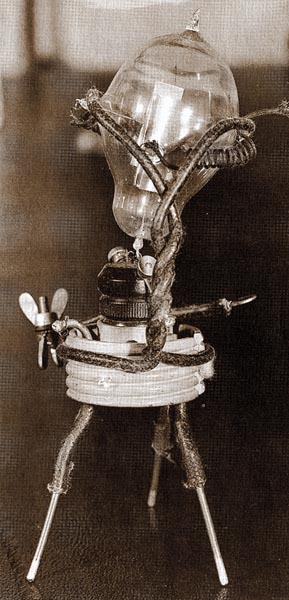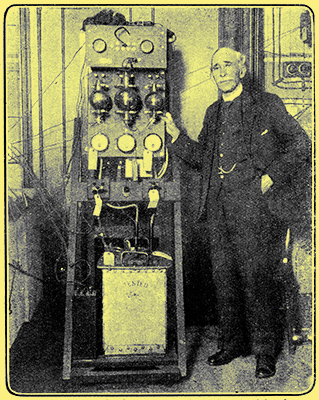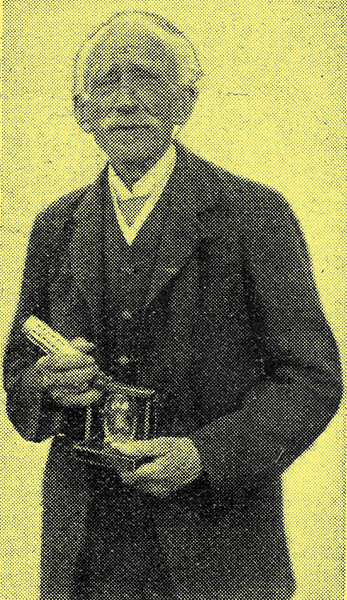|
Contents
(Within the text click a heading to return here)
Very Happy Thought
Nonagenarian
Consultant

You probably would not think of building a radio detector from a light bulb, but that is what Ambrose Fleming did in 1904. The result was what he called the 'oscillation valve', now better known as the thermionic diode. It was only two years later when Lee De Forest added a third electrode to make the first primitive triode. These two classic inventions led to a fight between the two inventors, but they also led to the now-vast, worldwide industry we call electronics.
The story begins with that great American inventor, Thomas Edison. In 1883, he probed inside an incandescent light bulb, first with a wire and then with a metal plate. He found that if this electrode was connected to the positive end of the filament via a galvanometer then a current was detected. If it was connected to the negative end, no current flowed. A little later, using a separate battery in the plate or anode circuit, J Elster and H Geitel showed the unidirectional nature of the current flow.
This 'Edison effect' was studied by many people over the following 20 years, particularly to examine thermionic emission. Fleming studied it 'carefully' in 1883 and again in 1896, and he may have discussed it with Edison when he met the 'Wizard' during his trip to the USA in 1884. Certainly, for 20 years it was a well known phenomenon before anyone thought of an important application for it.
Fleming's real invention was the use he found for the established Edison effect as a rectifier of high-frequency oscillations. Edison kicked himself when he realised the opportunity he had missed, even though he held what is now seen as the first patent in electronics - the effect used as a voltage indicator (1884).
Fleming's career, meanwhile, had progressed over those 20 years. In 1896 he experimented with methods of focusing cathode rays and three years later he was appointed scientific adviser to the Marconi's Wireless Telegraph Company. In this role he specified equipment for the famous transatlantic signal transmission of 1901. He had also gained extensive experience of consultancy, to the National Telephone Company and the Ediswan Electric Light Company. With all this highly relevant experience he was in an ideal position from which to make his famous contribution to electronics.

It was in October 1904 that Fleming had what he described as 'a sudden, very happy thought'. Telephones and meters were too slow to register the positive-negative cycling of a high frequency radio signal and therefore only indicated the average value, which was zero. Knowing that a light bulb with a hot filament and an insulated plate sealed within it would only pass current in one direction, he speculated that this might act as a rectifier for the high-frequency currents. He asked his assistant, G B Dyke, to test the idea - and it worked! The next month he wrote to Marconi, 'I have been receiving signals on an aerial with nothing but a mirror galvanometer and my device'.
It would be nice to think that Fleming made his fortune from this pivotal invention, but it brought him relatively little joy. Marconi's held the patent, and manufactured and used some diodes. But in this early form they were no panacea for all radio detection problems and they played only a small part in the early years of radio.
A couple of years later H H Dunwoody, of the De Forest Wireless Co., produced an important rival - the crystal detector. This was part of De Forest's determined effort to challenge Marconi's dominance of the radio scene. In 1905 De Forest patented the two-electrode valve with the double battery Elster-Geitel connection instead of the single battery circuit used by Fleming. He called his diode an 'audion'. Fleming felt that his invention had been hijacked and he accused De Forest of plagiary. A bitter row ensued.
In October 1906, De Forest added the third electrode to make the first triode. Unfortunately he still called it an 'audion', the name he used for his diode, and confusion reigned. The dispute with Fleming was prolonged. However, at no time did Fleming ever claim to have invented the triode. Though he experimented with zigzag wires as alternatives to metal plates for the anode he never used the two together. As he himself wrote, 'Sad to say, it did not occur to me to place the metal plate and the zigzag wire in the same bulb and use an electric charge of positive or negative on the wire to control the electron current to the plate'.
John Ambrose Fleming lived to the ripe old age of 95, and late in life became very deaf - this was seemingly a family trait, for his sister suffered similarly. One story from his time as Professor of Electrical Engineering at University College, London, recalled a loud conservation between the two of them in which his sister told him not to be so cantankerous - at times his colleagues thought his deafness varied at will to suite his purposes, becoming 'impenetrable' when he so wished.
Fleming was born at Lancaster on 29th November, 1849, the oldest of the seven children of a Congregational minister. His father, he said, was descended from 'a long line of Scotch ancestors of Flemish origin'. His mother's family came from Swanscombe in Kent and were pioneers of the manufacture of Portland cement.
In 1854 his parents moved to London where Fleming was to spend almost 70 years of his life. When he finally retired at 77, after an action packed working life, he moved to the seaside, to Sidmouth in Devon, where he enjoyed nearly another 20 years before his death on 18th April 1945. He married twice but had no children. His first wife, Clara Ripley, died in 1917 but his second, Olive Franks, Whom he married in 1933, survived him.
Fleming started school at about the age of ten, attending a private school where he particularly enjoyed geometry. Prior to that his mother tutored him and he had learned, virtually by heart, a book called the 'Child's Guide to Knowledge', a popular book of the day - even as an adult he would quote from it. His schooling continued at the University College School where, although accomplished at maths, he habitually came bottom of the class at Latin.
Even as a boy he wanted to become an engineer. At 11 he had his own workshop where he built model boats and engines. He even built his own camera, the start of a lifelong interest in photography. Training to become an engineer was beyond the family's financial resources but he reached his goal via a route which alternated education with work.
He enrolled for a BSc degree at University College, London, in the mid-1860s and studied under the mathematician A de Morgan and the physicist G Carey Foster. After two years he left because of a shortage of money and took a job with a shipbuilder in Dublin. The work was so dull that he quit after a few months and found work with a stock jobbing firm on the London Stock Exchange.
For two years he earned his living in the financial world. Later, as a teacher, he preached that every boy and girl should have some practical training in 'the bulls, the bears and the stags of The Stock Exchange' and 'their efforts to make money out of the trustful and optimistic public'.
At the Stock Exchange his worked finished at the early hour of 4 o'clock. So it was not only about the bulls and bears that he learned, for he completed his degree through evening study, graduating in 1870 with a first class degree.
For 18 months, from January 1871, he replenished his funds as a science teacher at Rossall School before resigning to return to his studies, this time as a student of chemistry at the Royal College of Science in South Kensington in London (now Imperial College). It was while there that he first studied the voltaic battery which became the subject of his first scientific paper. This turned out to be a unique honour, for it was the first paper to be read to the new Physical Society of London (now the Institute of Physics) and appears on page one of volume one of their Proceedings.
Financial problems again forced him to work for his living and in the summer of 1874 he became science master at Cheltenham College, a public School, earning £400 per year. His own scientific research continued and he corresponded with James Clerk Maxwell at Cambridge University. After saving £400, and securing a grant of £50 a year, in October 1877 he once again enrolled as a student, this time at Cambridge. He was now 28 years old. Maxwell's lectures, he admitted, were difficult to follow. Maxwell, he said, often appeared obscure and had 'a paradoxical and allusive way of speaking'. We are told that on occasions Fleming was the only student at those lectures.
In due course Fleming again graduated, this time with a first in chemistry and physics. He then got a DSc from London and served one year at Cambridge as a demonstrator of mechanical engineering before being appointed as the first Professor of Physics and Mathematics at the University of Nottingham. But after less than a year he left.
Up to this stage in his career Fleming had proved himself as a brilliant scholar and a gifted teacher, but with a stronger aptitude for learning than for being an employee. While he might have appeared as a perpetual student he was now to find his forte in life.
Cousins can be useful - Fleming's was a Mr Arnold White who happened to be secretary to the Edison Telephone Company in London, and through him Fleming was offered the post of consultant. The telephone business went through a period of great change, including mergers and the extension of the Post Office monopoly from telegraphs to telephones, and Fleming took an active part in the ensuing litigation.
White was also the secretary of the new Edison Electric Light Company and Fleming duly became scientific advisor there too. He appears to have obtained a number of orders for the company including one for the first Admiralty Ship to have electric lighting. It was on behalf of this company (by that time merged with the Swan Electric Light Company) that he visited America in 1884, during which visit he met Edison.
By that time Fleming's reputation was such that in 1885 he was invited to become the first Professor of Electrical Engineering at University College, London. At last he had a position which really suited his many and varied talents. London always appealed to him and his light teaching duties (one hour a week during the first few years) allowed plenty of time for consultancy.
When he took up his new position, which he retained until his retirement, the only equipment he received was 'a blackboard and a piece of chalk!' However he persuaded the authorities to give him a small room and a £150 grant. Largely due to his efforts £5000 was received in 1896 to establish an electrical laboratory.
His interests ranged widely over the years. At various times he specialised in transformer tests (acting as a consultant to Ferranti), standards and measurements, incandescent lamps and photometry, the effects of low temperatures on the electrical resistance of metals (with Sir James Dewar), and (of course) thermionics. In his retirement he was for 15 years president of the Television Society of London. He received many honours, including the Fellowship of the Royal Society in 1892, medals from the scientific and engineering institutions and, in 1929, a knighthood.
He has been described as a born teacher and gave meticulously prepared public lectures. Showmanship, however, was not allowed into his student lectures. As we have seen he was also an accomplished photographer. In addition, he painted watercolours and enjoyed climbing in the Alps. His interests were not those which entailed much socialising and he disliked organised games.
He was a devout Christian and preached on one occasion at St Martin-in-the-Fields in London. Having no children, he bequeathed much of his estate to Christian charities, especially those that helped the poor. But of his many achievements his enduring fame rests on turning a light bulb into the first electronic valve.

Dr J A Fleming at 2LO in March 1923.

Twenty nine years after. Sir Ambrose Fleming photographed in 1933 with a Catkin valve and his original Fleming valve of 1904.
|